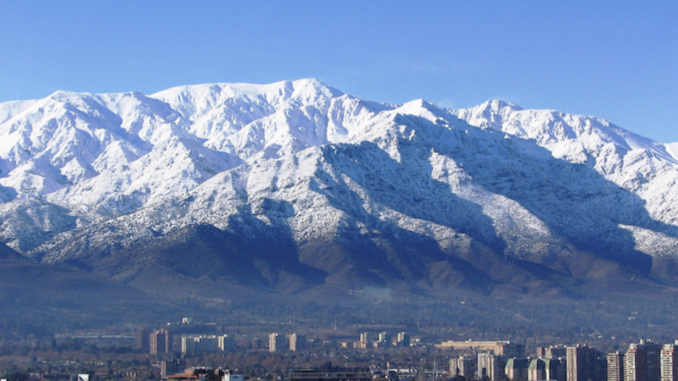
More writings by uncle, John Alldridge. This time he is reporting from South America in 1960 for the Birmingham Evening Mail – Jerry F
Over The Stone Curtain of The Andres
Buenos Aires was as far south as I was going. From there I was due to turn sharp right, as it were, and strike west across the Andes to the Pacific.
I wasn’t sorry to leave. The weather had changed for the worse. Most mornings now it was wet and misty; and the winds blowing straight up from the South Pole had a churlish nip in them. I was glad to be flying off into the sun again …
Nothing has done more to bring South America into the middle of the twentieth century than the aeroplane.
From Rio it used to take a month by boat to reach Manaos in the centre of the Amazon basin. Today an aeroplane covers the 1,700 miles in nine hours.
Until quite recently Bolivia depended on the Argentine for its meat. Now, in the almost uninhabited region of Beni, the wild cattle have been rounded up, an airfield laid out, and a refrigerator plant set up with equipment flown in. Now most Bolivians get home-bred meat distributed by air.
Of course, you can go by rail from Buenos Aires to Santiago. It is one of the most dramatically exciting — and exhausting — train journeys in the world. At one point the line climbs to 13,000 feet: and doctors in white coats walk up and down the train ready to give handy whiffs of oxygen.
But it takes nearly two days. So I chose to go by air which takes only two-and-a-half hours.
And on this flight Panagra laid on one of those fantastic aerial set-pieces which occasionally relieve the monotony of flying.
One moment we were in thick cloud; the next, we were out in the sun and flying at wing-tip level—or so it seemed—with the Andes.
I have flown the Alps several times. But never have I felt the sheer, unnerving excitement that grips you when you cross the Andes for the first time. These mountains come right up at you from the roots. They are as jagged as broken teeth; and needle-sharp on top.
Sometimes, flying in and out between these peaks, the plane seemed to be playing a breathtaking game of hide-and-seek. And as you fly on west they grow higher and higher. Until you feel like a very tired fly trying to get over a very high wall.
You’ll never make it, you think, in a moment of panic. But, of course, you do …
Glance at the map and you will see that Chile looks like a snake. A snake with a backbone 2,900 miles long and a belly never more than a hundred miles wide. That backbone is the sheer rock face of the Andes. Cut off as they are from the hustle and bustle of Buenos Aires and Montevideo, the Santiagos live in a world of their own, moving at a tempo of their own choosing.

Santiago, Chile. Vista desde Las Condes a La Reina,
Individuo from Santiago, Chile – Licence CC BY-SA 2.0
Life here is easier and simpler. Here you find neither the arrogance of the Argentine nor the brashness of the Brazilian.
Chile is Spanish much more than American. It has the finest wines, the sweetest songs, the prettiest girls — and some of the direst poverty — in South America.
This city of Santiago, the fourth largest on the continent, is not particularly dramatic in itself. But it is blessed with the most stunning setting of any capital city in the world.
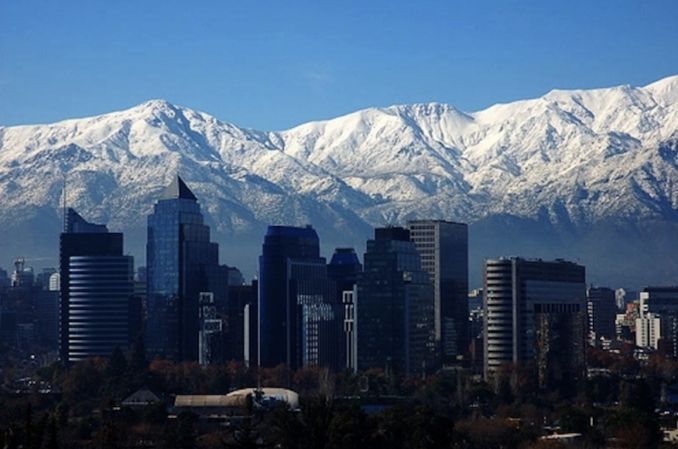
Skyline Santiago City, Chile,
Victorddt – Licence CC BY-SA 4.0
It is almost entirely circled by mountains, some of them 20,000ft high and eternally snow-capped. You get the best view of them from a little wooded knoll, right in the middle of the city, called Santa Lucia.
The thing to do is to climb that tiny hill just before dusk and watch the dying sun playing on the snow. By some magic of its own the colours fade and change from old rose through saffron to deepest indigo. Until all that is left is a sinister, jagged black cut-out against the velvet of the night sky. And there you are, alone in the darkness. While below you the neon signs snap into fire …
This Santa Lucia is a great place for lovers. And why not? Hollywood has nothing like this.
When I arrived Chile was busy celebrating the 150th anniversary of its liberation by a fighting Chilean-Irishman from County Sligo, by name Bernardo O’Higgins.
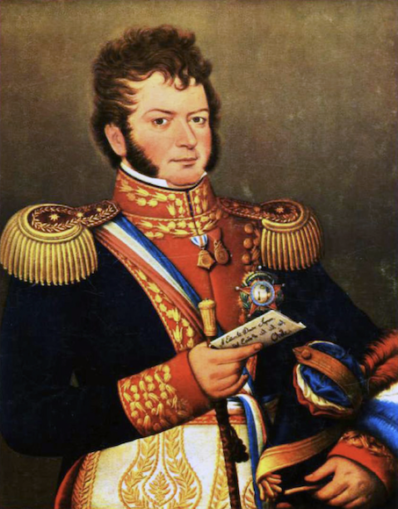
Bernardo O’Higgins,
José Gil de Castro – Public domain
You find the name everywhere — on the city’s finest avenue, on countless plazas and hotels.
The Liberator got solid support from the commander of the Chilean Navy of the time, who happened to be a Scot, Lord Cochrane, and one of Nelson’s best captains. They are very proud of him, too. And his great-great-grandson, who had flown in for the celebrations, was being feted royally.
***
This feudal volcano may strike without warning …
They come from hard-fighting stock, these Chileans. The Spaniards never conquered them; they merely fought them to a standstill and then tactfully bypassed them.
And the original inhabitants, the Araucanian Indians, refused to accept Chilean sovereignty until late on in the nineteenth century.
They fought three major wars last century — against Peru, early on; against Spain in 1866; and against Peru and Bolivia together in the eighties — and won all three. Even now they have an army which, man for man, is the best in Latin America. It is largely modelled on the old German Army. (One of its former instructors was a certain Captain Ernst Roehm).
And it comes as something of a shock to see its crack cadet regiments goose-stepping in the field-grey and coal-scuttle helmets of Hitler’s Wehrmacht. But despite their warlike past the Chileans are without doubt the friendliest people I have met on my journey.
On the spur of the moment I decided to take the little electric train out to El Volta, a derelict mining camp up in the mountains from where you get an incomparable view of the High Andes.
I had no idea how to get there. But the hotel porter handed me over to the taxi driver; who passed me to the stationmaster; who delivered me personally to the guard; who handled me like first-class mail.
And even took me out to lunch at the end of the line …!
Incidentally, Chile is the only South American country which hasn’t demanded a visa from me.
So it is sad to see such friendly people living very often in such dire distress.
Because they are a proud people it doesn’t show on the surface. I wondered why my cab driver spoke such excellent English. I found that he held a degree in music, but couldn’t keep a wife and family on what it paid. So he had joined up with his brother, pooled their savings and bought a taxi.
By working in shifts round the clock, seven days a week, they can just make ends meet.
He prefers the night shifts. “At least then I can listen to some good music on the cab radio,” he grinned wryly.
Chile’s most disturbing problem is how to grow enough food to feed its increasing population. It seems to me it will never begin to solve that problem while a handful of big landowners possess what good land there is.
Many of them have held their land direct from their ancestors who received it in gift from the Spanish Crown centuries ago. Statistics are hard to obtain. Chile is very touchy on the subject of land tenure.
But one hacienda, near Santiago, is believed to cover 618 square miles.
Out-of-date, and even downright primitive, farming methods have allowed soil erosion to wash away the good earth.
The rivers of Chile run red with this precious topsoil. Not for nothing is it the colour of blood …
On these vast estates live peons whose condition is only one stage better than the French peasant immediately before the Revolution.
He now receives a living wage; and is free to move. But iron tradition holds him to the estate — where his home is a mud house on a mud floor, thatched and barely furnished. There is no water laid on; and his cooking is done outside in all weathers.
Ironically Chile has enough natural resources to raise the standard of living to among the highest in South America.
It has rich deposits of iron ore, manganese and coal. For years Chile was the world’s largest exporter of nitrate. (Until a German called Harber invented synthetic nitrates and put an end to that pipe-dream.) It still has the largest open copper mine in the world.
Huge American loans and armies of American technicians are working desperately hard to bring these backward industries in line with world markets.
Chilean miners and engineers have proved surprisingly adaptable. So much so that today the mining and industrial workers represent a quarter of all labour in the country. It may seem impertinent on my part to suggest it, but it seems to me that one day the pot is going to start boiling with a vengeance and the whole structure of feudal Chilean society will be blown sky-high.
But, as I said, these things do not appear on the surface. They are like the volcanoes which so often have racked this lovely country and strike without warning.
They were certainly not apparent last Sunday morning when, with hundreds of Santiagoans, I went up the funicular to the top of Colle San Cristobal, the city’s Hampstead Heath.
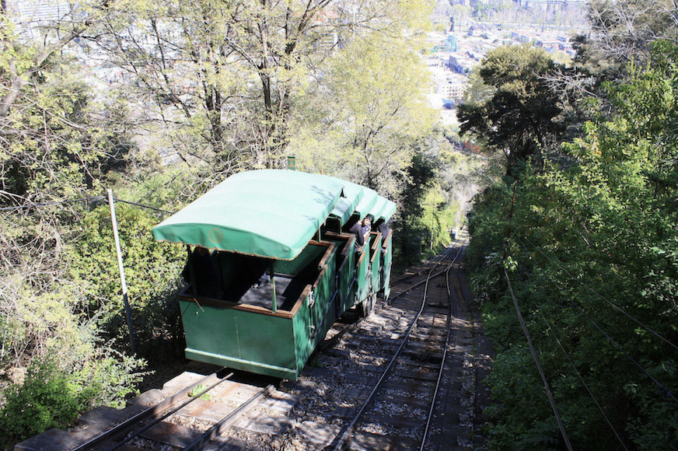
https://commons.wikimedia.org/wiki/File:Funicular_Stgo.jpg,
Robert Cutts from Bristol – Licence CC BY-SA 2.0
Here a benign Madonna stands guard over the city. And here we fed the llamas in the toy zoo; and picnicked off oranges and empanadas, which are a sort of Cornish pasty filled with raisins, stuffed olives, meat and hot peppers.
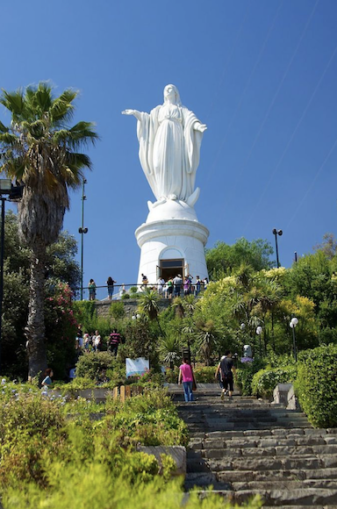
Virgin Mary statue on Cerro San Cristóbal,
McKay Savage from London, UK – Licence CC BY-SA 2.0
Below us the city was hidden in a heat haze. Between us and the sky there were only the mountains …
Reproduced with permission
© 2023 Newspapers.com
Jerry F 2023



